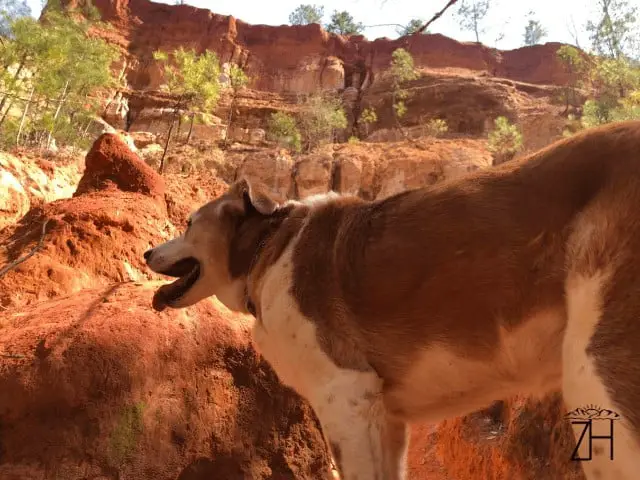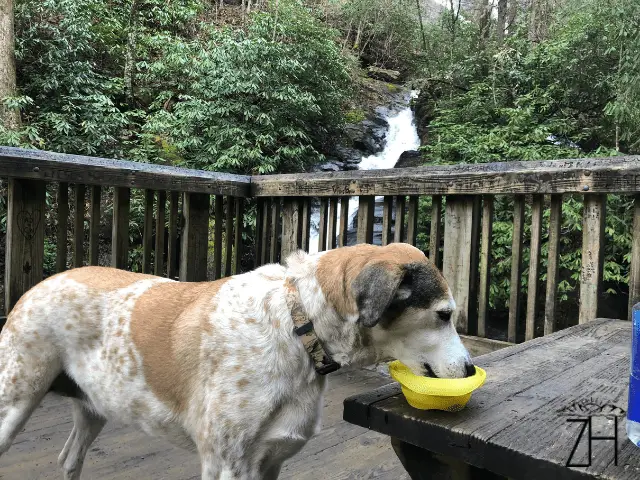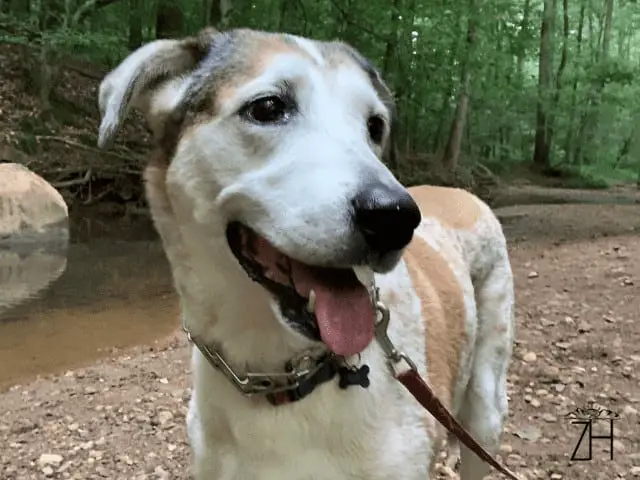Our Chompers and Mia love to hike and we hike with them on almost a weekly basis year round.
However, during the summer months here in Georgia, it can get extremely hot and humid. Our four legged hiking partners can suffer from many of the same heat related risks that we do. Dogs can suffer from heat exhaustion and even heat stroke on hot summer days if you’re not careful.
They can also suffer from paw pad injuries from walking on very hot and rocky terrain. Ouch!
In this article, we’re going to talk about how hot is too hot to take your dog hiking, the signs and symptoms of heat stroke so you know what to watch out for and finally our 7 tips for hiking with dogs in hot weather.
Let’s get started.
This page contains affiliate links. If you use these links to buy something I may earn a commission. Thanks.
How Hot is Too Hot for a Dog Hiking?

When we say ‘hot weather’, what exactly is hot? 75 degrees? 80? 90?
There is no exact number when it comes to how hot is too hot. A lot of factors can come into play when determining if it’s too hot for your dogs to be hiking.
Humidity obviously plays an important role in how your dogs will respond to the heat.
Sudden spikes in temperature that your dog (and you for that matter) is not acclimatized to yet, can cause temperatures as low as 75 degrees to be a risk.
Other factors like elevation, your dog’s age, fitness and breed can also all play a part.
Try to take all these factors into consideration when planning your hike with your dogs in hot weather and when in doubt, ask your vet!
Finally, while there is no right answer for how hot is too hot on the low end, according to laws in some areas there does appear to be a pretty solid answer for how hot is too hot on the high end. In some places it is illegal to take your dog hiking in triple-digit weather.
Signs and Symptoms of a Heat Stroke in Dogs
Before we get into our tips for hiking with dogs in hot weather, we felt it very important for you to be aware of the signs and symptoms of a heat stroke in dogs.
This is a very real and very dangerous risk if you’re hiking on those hot summer days and something you should always be assessing throughout your hike with your pups.
According to the Humane Society, some of the symptoms to watch out for include heavy panting, glazed eyes, a rapid heartbeat, difficulty breathing, excessive thirst, lethargy, fever, dizziness, lack of coordination, profuse salivation, vomiting, a deep red or purple tongue, seizure and unconsciousness.
In particular, watch out for heavy panting that doesn’t subside.
Panting is a normal process for dogs to cool themselves down and is to be expected when being active outside in warm weather. But, if your dog’s panting is constant and continues even after resting for a bit, it’s a sign your dog is overheating.
7 Tips for Hiking with Dogs in Hot Weather

Here are a few tips to keep in mind so you and your dogs can still enjoy hiking during hot weather.
Plan Your Hike (shady trails if possible)
Take some time to plan your hike ahead of time.
We try to look for trails with limited elevation and plenty of shade if we’re going to be hiking in warmer weather.
If you live out west (in the US) finding a trail with lots of shade may be easier said than done, but it definitely will make a difference if you can find one.
We also plan out shorter hikes. If we’re concerned at all about the heat, then those long loops are not going to be an option.
Avoid the Midday Heat
Hiking early in the morning is the best time to hike with your dogs when the weather is hot.
By simply getting up early and hitting the trail, temperatures can be around 15-20 degrees cooler. That’s a huge difference!
Once we hit the summer months here in Georgia, we try to be on the trail no later than 7:30AM. By 9AM we’re off the trail and back into the air conditioning.
You can also get a bit of a reprieve from the heat later in the evening, but not nearly as much as first thing in the morning.
Bring Plenty of Water

You should have somewhere between a 1/2 liter to a full liter of water for every hour you plan to hike for yourself.
In addition, you should have 8 ounces of water per dog per hour.
Those are the guidelines we follow and then I always bring an extra “just in case water”. I’ve honestly never dipped into the “just in case” bottle, but I always feel better having it.
Finally, we keep some bottles cold in a small soft-sided cooler in our car. It’s always nice to have an ice-cold drink once you hop back into the car. Trust me, your pups will REALLY appreciate it too!
If you don’t already have one, I highly recommend getting a collapsible bowl for getting water to your dogs both on the trail and in the car. It’s a complete game-changer.
Cool Off In (But Don’t Drink) Water Sources
If you happen to pass a creek or a pond and want to use it as an opportunity to let your dog cool off a bit, go for it!
Obviously, be aware of dangers like snakes or deep or fast moving water – common sense can go a long way here.
Cool water is great for helping your dog cool off, but don’t allow them to drink the water, because they may really want to!
Dogs can get sick from ingesting some of the same bacteria that can be found in water on the trail no different than us. So, if you wouldn’t drink the water, don’t let them drink it either!
Take Breaks
If you’re hiking with your dogs in hot weather, don’t be shy about stopping and taking some breaks.
Find a good shady spot to sit down and take in the view. Give you and your dog a few minutes to rest and cool down. Get out your water and take a close assessment of how your dog is doing.
If you notice any of the signs or symptoms of heat stroke like we mentioned above, then it’s probably time to start heading back!
Know Your Dog’s Fitness Levels (and Breed & Age)

If your dogs are avid hikers like ours are, they’re going to respond to the exercise and heat much differently than a dog that’s just beginning to be more active.
You should know your dog’s abilities and how they’ll respond to hiking before you hit the trail in general, and this is especially true if it’s going to be warm out.
This is also going to be dependent on your dogs breed and age. Senior dogs will struggle more in hot weather than a younger dog and some breeds like dogs with thick hair or short noses like shih tzus and pugs.
If you’re just starting to get more active with your pooch, start with longer walks around your neighborhood. If your neighborhood has some gentle inclines and declines, even better.
Once you’re confident your dog is comfortable with a 45 minute to an hour walk, then go ahead and start on the trail for similar times and distances.
Until then, I wouldn’t recommend taking your dog out into the woods where you may end up being pretty far from help if your dog doesn’t respond well to the activity, the heat or both.
Dog Boots and Paw Wax

In addition to the hot air, you also need to make sure you’re aware of the hot ground that your dog is going to be walking on.
This is something that goes unnoticed with some dog owners because, well, we all have shoes and walking on hot gravel or pavement isn’t something we have to worry about.
Touch the ground with the back of your hand. If it is hot to the touch then it’s going to be hot on your dog’s paws as well. Walking on really hot terrain can cause your dog’s paw pads to dry, crack or even tear.
If you’re concerned that the trail may be too hot, there are a few ways you can protect your dog’s feet.
First, get a pair of dog boots. They’re relatively cheap (a full set should cost you less than $30) and effective. And, not only only are they good in the summer for hot terrain, they also work great to protect their feet against the cold and snow.
The main drawback to these boots is that some dogs are going to HATE wearing them. Some will eventually come around to not minding them, but some never take to them.
If you’re dog falls into that last group, you can opt for some Musher’s Secret Dog Paw Wax. It also works great to help protect your canine’s paws from the elements.
Final Thoughts
If you’re going to be taking your dog out hiking in hot weather, be very mindful of trail you pick, the shade and humidity in addition to just the temperature.
Check in with your dog often to see how they are doing. Many dogs, like ours, enjoy being on the trail so much that they won’t stop until they physically can’t go. It’s your job to protect them so it doesn’t get to that point.
You can still take your furry friends hiking in hot weather, but above all else, be smart and be safe!
